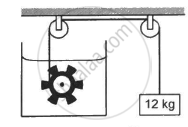Advertisements
Advertisements
Question
Solve the following problems:
Equal heat is given to two objects A and B of mass 1 g. Temperature of A increases by 3°C and B by 5°C. Which object has more specific heat? And by what factor?
Solution
\[s = \frac{∆ Q}{m ∆ T}\]
Let Q cal of heat is given to both A and B.
For body A,
\[s_1 = \frac{Q}{1 \times 3} = \frac{Q}{3} \text {cal }g^{- 1} {}^o C^{- 1}\]
For body B,
\[s_2 = \frac{Q}{1 \times 5} = \frac{Q}{5} \text { cal } g^{- 1} {}^o C^{- 1}\]
Now,
\[\frac{s_1}{s_2} = \frac{\frac{Q}{3}}{\frac{Q}{5}} = \frac{5}{3}\]
\[ \Rightarrow s_1 = \frac{5}{3} s_2\]
Thus, specific heat capacity of body A is more than body B and by a factor of \[\frac{5}{3}\].
APPEARS IN
RELATED QUESTIONS
Calculate the mass of ice required to lower the temperature of 300 g of water 40°C to water at 0°C.
(Specific latent heat of ice = 336 J/g, the Specific heat capacity of water = 4.2J/g°C)
A copper vessel of mass 100 g contains 150 g of water at 50°C. How much ice is needed to cool it to 5°C?
Given: Specific heat capacity of copper = 0.4 Jg-1 °C-1
The Specific heat capacity of water = 4.2 Jg-1 °C-1
The Specific latent heat of fusion ice = 336 Jg-1
Water in lakes and ponds do not freeze at once in cold countries. Give a reason is support of your answer.
What do you mean by the following statement?
The specific heat capacity of copper is 0. 4 Jg-1 K-1?
Describe a method to determine the specific heat capacity of a solid, like a piece of copper ?
Why do bottled soft drinks get cooled, more quickly by the ice cubes than by the iced water, both at 0℃?
Explain the meaning of green house effect.
Who shall pay carbon tax ?
The specific heat capacity of a body depends on _____________ .
Figure shows a paddle wheel coupled to a mass of 12 kg through fixed frictionless pulleys. The paddle is immersed in a liquid of heat capacity 4200 J K−1 kept in an adiabatic container. Consider a time interval in which the 12 kg block falls slowly through 70 cm. (a) How much heat is given to the liquid? (b) How much work is done on the liquid? (c) Calculate the rise in the temperature of the liquid neglecting the heat capacity of the container and the paddle.

Does the specific heat capacity of a substance depend upon its mass and rise in temperature only?
Give two reasons as to why copper is preferred over other metals for making calorimeters.
Derive an expression for finding out the specific heat capacity of a body (solid) from the readings of an experiment given below:
(i) Mass of empty calorimeter (with stirrer) = m1 gm
(ii) Mass of the metal piece = M gm
(iii) Mass of colorimeter and water = m2 gm
(iv) Initial temperature and water = t1°C
(v) Temperature of hot solid (metal piece) = t2 °C
(vi) Final temperature of the mixture = t°C
(vii) Specific heat of calorimeter = 0.4 J gm / °C
Solve the following problem.
Specific latent heat of vaporization of water is 2.26 × 106 J/kg. Calculate the energy needed to change 5.0 g of water into steam at 100 ºC.
How much heat energy is necessary to raise the temperature of 5 kg of water from 20°C to 100°C?
Derive Meyer’s relation for an ideal gas.
Which of the following substances (A, B and C) has the highest specific heat?

Prove the Mayer's relation `C_p - C _v = R/J`
